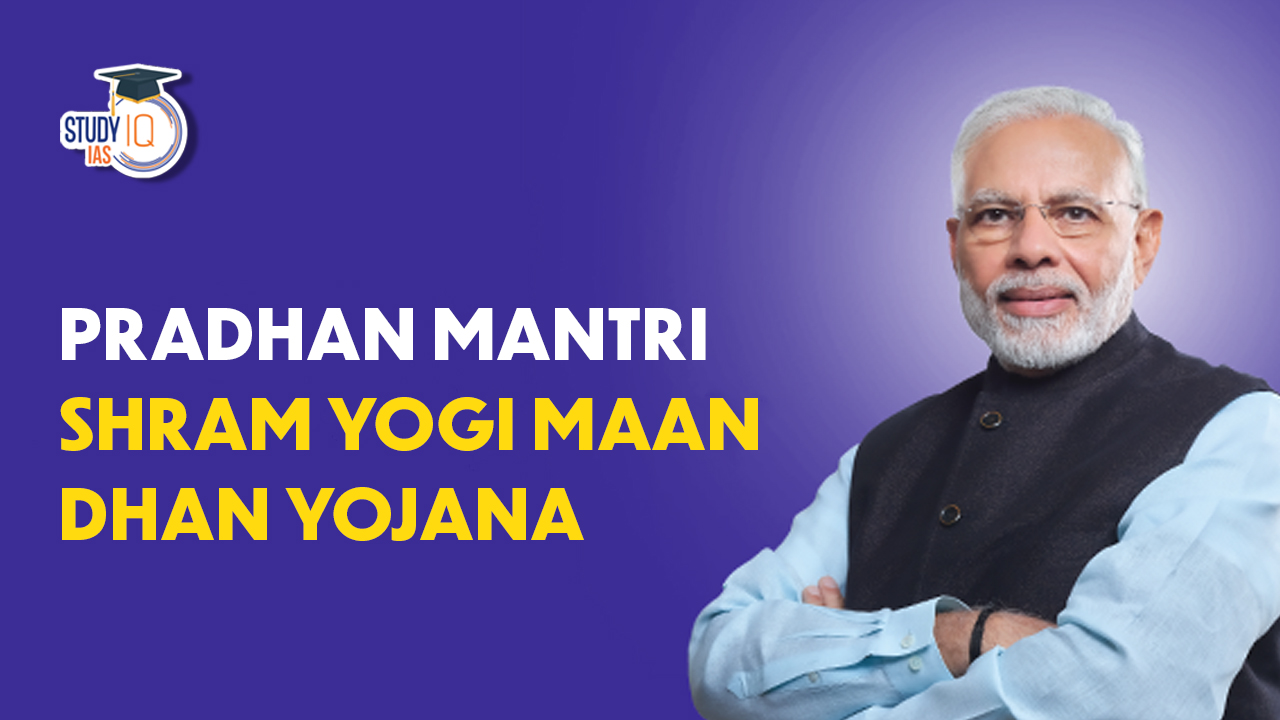Table of Contents
Context: The budget allocation for the PM Shram Yogi Maandhan Yojana in 2025-26 has increased by 37% compared to the previous year.
Current Status of Pradhan Mantri Shram Yogi Maan-dhan Yojana (PM-SYM)
The Pradhan Mantri Shram Yogi Maan-dhan Yojana (PM-SYM) scheme has enrolled 46,12,330 beneficiaries across India, covered 36 states/UTs and covered 3,52,598 CSCs.

Current Status of Implementation:
- Coverage: 36 States/UTs
- Enrollments: ~46,12,330 (March 2025)
- Top 3 States: Haryana, Uttar Pradesh, Maharashtra.
Pradhan Mantri Shram Yogi Maan-dhan Yojana (PM-SYM)
The Pradhan Mantri Shram Yogi was launched to protect the elderly and give unorganised workers social security. Through the auto-debit function, the government would use this programme to directly deposit Rs 3000 from the beneficiaries’ savings or Jan Dhan accounts. It is a voluntary and contributory pension scheme launched by the Government of India in 2019 to provide social security to workers in the unorganised sector.
The Pradhan Mantri Shram Yogi Maandhan aims to safeguard the elderly and provide unorganised employees with social security. A minimum assured pension of Rs. 3000 per month is provided to beneficiaries of the voluntary and contributory pension system known as PM SYM once they turn 60. The beneficiary’s spouse is entitled to 50% of the pension as a family pension in the event of the beneficiary’s demise. Family pensions are only available to spouses.
|
Pradhan Mantri Shram Yogi Maan-dhan Yojana Overview |
|
| Particulars | Details |
| Name of the Scheme | Pradhan Mantri Shram Yogi Mandhan Yojana (Central Sector Scheme) |
| Launched in | 2019 |
| Ministry | Ministry of Labour and Employment |
| Nature of Scheme | Voluntary and Contributory Pension Programme |
| Beneficiaries | Unorganised Sector Worker |
| Eligibility | Aged between 18 to 40 years and earning less than Rs.15000 per month |
| Monthly Contribution | Between Rs 55 and Rs 200 till the age of 60 years |
| Pension Fund Managed by | Life Insurance Cooperation (LIC) |
| When the beneficiary turns 60, a guaranteed pension payment of Rs. 3000 is made to them. The LIC will be in charge of both managing the pension fund and making pension payments. | |
Key Features of Pradhan Mantri Shram Yogi Maan-dhan Yojana
- PM SYM, a Central Sector Scheme that would be administered by the Ministry of Labour and Employment.
- It is a voluntary and contributing pension plan in which the government and the beneficiary each contribute an equal amount to a pension fund.
- The beneficiary’s age at the time of registration affects the contribution amount.
- All LIC branch offices, ESIC/EPFO offices, and Central and State Government Labour offices shall educate unorganised workers about the Scheme, its advantages, and the procedure to be followed at their respective centres.
- When the beneficiary turns 60, a guaranteed pension payment of Rs. 3000 is made to them.
Eligibility of Pradhan Mantri Shram Yogi Maan-dhan Yojana
The eligibility for the Pradhan Mantri Shram Yogi Maan-dhan Yojana has been mentioned below in the table for different categories:
|
Pradhan Mantri Shram Yogi Maan-dhan Yojana |
|
| Particulars | Eligibility |
| Age Requirement | Entry age is between 18 to 40 years |
| Income Limit | Monthly Income Rs 15000 or below |
| Unorganised Sector Employment | Workers engaged in professions such as:
|
| Exclusion Criteria |
|
| Documents Required |
|
Contribution Structure in PM-SYM
| Age at Entry | Monthly Contribution (by Worker) | Equal Contribution by Government |
| 18 years | ₹55 | ₹55 |
| 20 years | ₹65 | ₹65 |
| 25 years | ₹80 | ₹80 |
| 30 years | ₹105 | ₹105 |
| 35 years | ₹150 | ₹150 |
| 40 years | ₹200 | ₹200 |
Beneficiaries of Pradhan Mantri Shram Yogi Maan-dhan Yojana
The beneficiaries that have been ensured under the Pradhan Mantri Shram Yogi Maan-dhan Yojana are:
- Any unorganised worker between the ages of 18 and 40 whose work is temporary and who earns less than Rs 15,000 per month.
- The employee shouldn’t be a taxpayer or be protected by any statutory social security programmes like the National Pension Scheme (NPS), Employees’ State Insurance Corporation, or Employees’ Provident Fund Organisation (EPFO).
- A monthly pension of Rs. 3000 would be given to an unorganised worker who joins the scheme and pays regular payments up until the age of 60.
- The spouse will get a monthly family pension following his or her passing that is equal to 50% of the pension.
- The beneficiary’s spouse will get a monthly family pension equal to 50% of the beneficiary pension if the beneficiary passes away while receiving the pension.
- A savings bank rate of interest will be paid on the contribution portion only if an eligible beneficiary withdraws from this Scheme within ten years of joining it.
- In the event that a qualified recipient passes away while receiving the pension, his or her spouse is only entitled to 50% of the pension as a family pension, which solely applies to the spouse.
Withdrawal from Pradhan Mantri Shram Yogi Maan-dhan Yojana
The exit provisions of the scheme have been left flexible in light of the difficulties and sporadic nature of these workers’ employability. Exit rules are as follows:
- If a subscriber leaves the programme in fewer than ten years, his portion of the contribution will be returned to him with interest at a savings bank.
- The beneficiary will receive their portion of the contribution, as well as any accumulated interest, at the higher of the savings bank interest rate or the actual interest received by the fund, if the subscriber withdraws after a period of 10 years or more but before reaching superannuation age, which is 60 years of age.
| UPSC PYQ |
Q. With reference to the Pradhan Mantri Shram Yogi Maan-dhan (PM-SYM) Yojana, consider the following statements: (2024)
Which of the statements given above is/are correct?
Answer: B |


 Bhashanet Portal : Empowering Multilingu...
Bhashanet Portal : Empowering Multilingu...
 Grameen Credit Score (GCS), Objectives a...
Grameen Credit Score (GCS), Objectives a...
 Plastic Parks Scheme, Objective and Fina...
Plastic Parks Scheme, Objective and Fina...





















